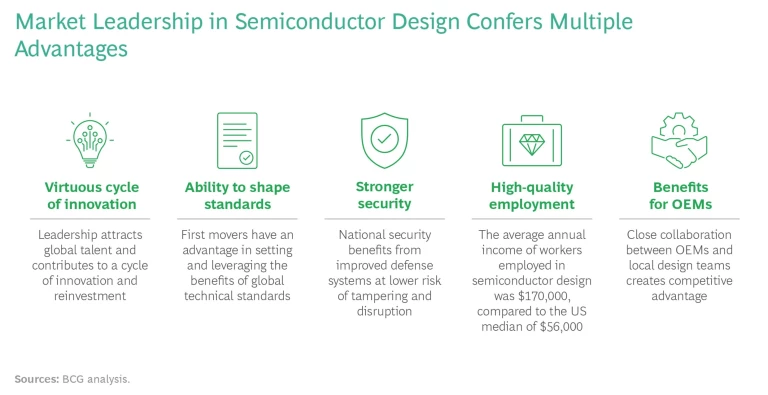Semiconductors
are ubiquitous, powering technologies that range from cell phones to the Mars rovers Curiosity and Perseverance, and economically important. In 2021, worldwide semiconductor sales totaled $556 billion. Semiconductor design—which includes design of both physical integrated circuits and associated software—accounts for roughly half of all industry R&D investment and value
US companies have played a leading role in semiconductor design, and as a result the US has benefited from a virtuous cycle of innovation, enhancing its ability to shape technical standards, strengthen national security, offer high-quality employment, and generate competitive advantage for original equipment manufacturers (OEMs) in adjacent industries. (See the exhibit.)

In recent years, however, the US’s share of design-related revenues has begun to show signs of a decline, dropping from over 50% in 2015 to 46% in
Should the US aim to defend its leadership position in design and reap the associated downstream benefits of design leadership, it would need to address three challenges.
Challenge 1: Design and R&D investment needs are rising. As chips have grown more complex, development costs have risen, especially for chips made on leading-edge manufacturing nodes. Today, the US private sector invests more in design R&D than any other region’s private sector does, but governments around the world offer significant incentives to attract advanced design, and the US risks falling behind. In addition, the relative level of public support for R&D in the US lags that of other regions. The overall share of semiconductor-specific design and R&D funded by public investment is 13% in the US, compared to an average of 30% across mainland China, Europe, Taiwan, Japan, and South Korea. Bringing US public investment in design and R&D into line with international peers—including, for example, direct incentives such as tax credits for advanced design and R&D performed in the US—will help ensure a level playing field for design in the US relative to other regions.
Challenge 2: The supply of design talent is dwindling. Although most of the world’s semiconductor design engineers today are based in the US, the US semiconductor design industry faces a shortage of skilled workers and is on track to see this shortage increase to 23,000 designers by 2030, given trends in the number of science, technology , engineering , and mathematics (STEM) graduates and the number of experienced engineers leaving the industry. Public and private sectors must work together to encourage more US workers to enter the field of design, as well as to encourage experienced designers not to leave the field or the country. Further, the private sector must continue to enhance the productivity of its workforce by developing and deploying new tools and prioritizing the highest value-add R&D and design.
Challenge 3: Open access to global markets is under pressure. Sales are the ultimate source of funding for investment in R&D, but tariffs, export restrictions, and other factors threaten US semiconductor players’ access to global markets, implicitly putting R&D reinvestment at risk. Secular trends may reverse some elements of globalization, but ensuring that markets remain as open as possible will benefit the US, which gains significantly from free trade and has the most to lose from proliferating restrictions.
The US private sector is likely to invest $400 billion to $500 billion over the next ten years in design-related activities, including R&D and workforce development. But to maintain leadership over the coming decade, the US needs complementary public-sector investments aimed at addressing the key challenges laid out above to strengthen both the domestic semiconductor industry and the country as a whole.
Further, the leverage provided by public-sector investments would be substantial. Our analysis suggests that each public dollar invested in design and R&D would induce additional private-sector investment in design and R&D, ultimately yielding $18 to $24 of design-related
As a result, public investment in design and R&D of approximately $20 billion to $30 billion through 2030 (including a $15 billion to $20 billion design tax incentive) would yield incremental design-related sales of about $450 billion over ten years, while also supporting training and employment for about 23,000 design jobs and 130,000 indirect and induced jobs, and fortifying the US leadership position in semiconductor design.





